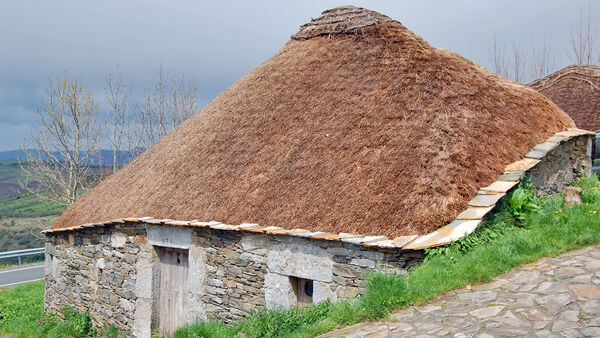O Cebreiro: Blast to the Past in Spain’s Galicia
In verdant Galicia, along the final stretch of the Camino de Santiago, lies the beautifully rustic village of O Cebreiro.
By Rick Steves
Perched on a high ridge, the impossibly quaint hobbit hamlet of O Cebreiro welcomes visitors to Galicia — a hilly, damp, green region in northwest Spain that feels vaguely Irish. O Cebreiro is a time-warp connection to an uncomplicated, almost prehistoric past, when people lived very close to nature, in stone igloos with thatched roofs. With sweeping views across the verdant but harsh Galician landscape, O Cebreiro (pronounced oh theh-BRAY-roh) is constantly pummeled by some of the fiercest weather in Spain.
O Cebreiro smells like wood fires, manure, and pilgrim B.O. The village is shared by two groups: a few simple townspeople, who cock their heads quizzically when they see an iPhone, and weary Camino de Santiago pilgrims on an adrenaline high after finally reaching Galicia. O Cebreiro marks the final stretch of their month-long, 450-mile pilgrimage to the city of Santiago de Compostela, along the Camino de Santiago (or Way of St. James). The town's dogs bark at each other territorially from across the street, completely ignoring the backpackers who regularly trudge through town.
For a taste of the local culture, get a snack or drink at one of the half-dozen very humble pub/restaurants, which feed pilgrims and other visitors hearty Galician cuisine in a smoky atmosphere. One local specialty is caldo galego, a traditional soup that originally came from the leftover stock used to prepare an elaborate Sunday feast (cabbage or turnip greens, potatoes, and so on). It's not too exciting, but it does provide comfort on a rainy day.
If you hear something that sounds like, but isn't quite Spanish, it's Galego — the distinctive language of Galicia. A mix between Portuguese and Spanish, Galego has gradually evolved to sound more like the latter. The most apparent difference is the change in articles: el and la become o and a — so the big Galician city La Coruña is known as "A Coruña" around here. The Spanish greeting buenos días is bos días in Galego. If you want to impress a local, say graciñas (grah-THEEN-yahs) — a super-polite thank you.
To see how local villagers used to live, visit the pallozas. From Celtic times 1,500 years ago, right up until the 1960s, the townspeople of O Cebreiro lived in these humble, round stone huts with peaked thatched roofs. Three of the nine surviving pallozas have been turned into a loosely run museum, where visitors can learn about the lifestyles of the people who lived in the huts.
Upon entering a palloza, which typically housed a dozen people (and their animals), you'll find two simple rooms: the only "private" room in the house, belonging to the parents, and a living area around a humble fire. Surrounding the fire are clever benches (which were also used as very hard beds) with pull-down counters so they could double as a table at mealtime. Cooking was done over the fire using a chain hanging from a big beam, while giant black-metal spirals suspended from the ceiling were used to smoke chorizo sausage.
Attached to the living area is a miniature "barn," where animals lived on the lower level, and people — kept warm by all that livestock body heat — slept on the upper level. Thanks to the ideal insulation provided by the thatch, and the warmth from the fire and animals, it was toasty even through the difficult winter.
In O Cebreiro, all roads lead to the village church. Founded in the year 836, Royal St. Mary's Church (Santa María la Real) is supposedly the oldest church on the entire French Road route of the Camino de Santiago. The interior of this pre-Romanesque building is surprisingly spacious, but very simple. The building is embedded in the ground, with sunken floors that added protection against winter storms. At a desk, a clerk stamps pilgrims' credentials and sells votive candles.
As dictated by ancient tradition, the baptistery is separate from the main part of the church, with its giant and very rough font used for immersion baptisms. In the chapel is a much-revered 12th-century golden chalice and reliquary, which holds items relating to a local miracle: A peasant from a nearby village braved a fierce winter snowstorm to come to this church for the Eucharist. The priest scoffed at his devotion, only to find that the host and wine had physically turned into the body and blood of Christ, staining the linens beneath them — which are now in the silver reliquary.
To get way off the beaten track, enjoy Spain at its rustic best by "playing pilgrim" for a few hours here in hauntingly beautiful O Cebreiro.

